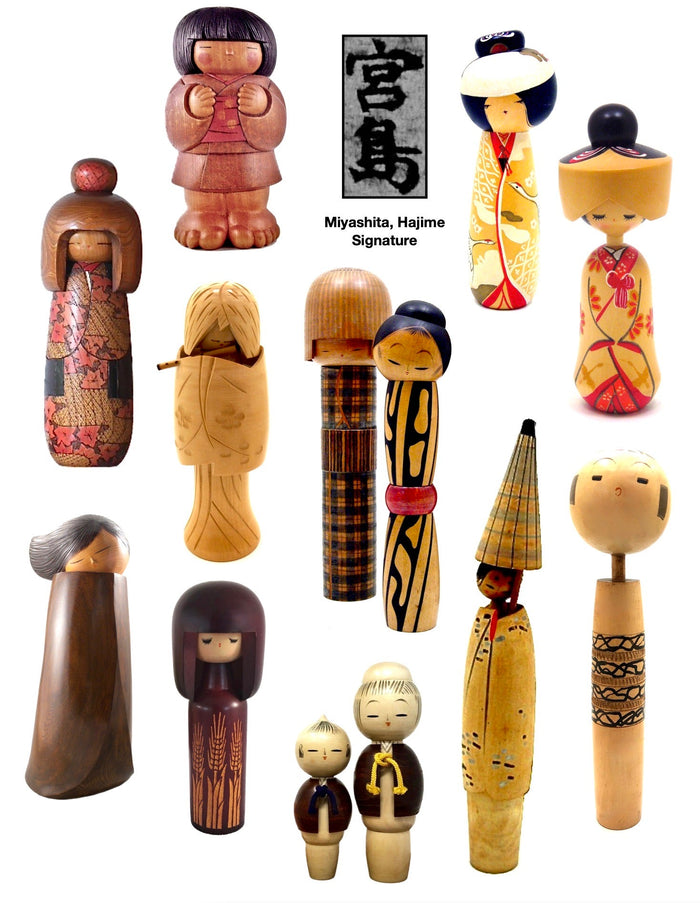



Vintage Sosaku Kokeshi Entitled: Kagamijishi by Miyashita, Hajime | Japanese Kabuki - Renjishi Lion Dancer Kokeshi
Dimensions: 9-0”h x 3-1/2”w x 3-1/4”d
Offered is a wonderful Kokeshi which depicts a Lion Dancer known as Kagamijishi, which is a shortened name of the Kabuki dance called the “Shunkyo Kagamijishi”. Kabuki is a form of traditional Japanese drama with highly stylized song, mime, and dance. Now performed only by male actors, using exaggerated gestures and body movements to express emotions, and performed in historical and domestic plays, drama, and dance.
This Kokeshi the Lion Dance character, (Mai), was a theme for this artist, for it portrayed the spirit of the lion, which is a contrast in character between the elegant femininity of Japanese women versus the dynamic masculine power of the lion spirit. The figure is made of solid wood, and is shown in a relatively simple juxtaposition of the form/body elements, which affords a contrasting effect as if dancing, emphasizing the natural white birch wood, (Shirakaba). The pose enhances the beauty of the doll and the poetic meaning translated through the minimally ornamented material. Along with simple relief carving for the body of the figure which consists of an outer Kimono and undergarment, complemented by wide-wrapped sleeves. The Kimono details two dark pink cherry blossoms as a color focus on her garment, along with several blossoms in shallow relief that are unpainted giving added texture to the overall figure. Her expressive face is partially covered with a simple purple and white flower painted fan representing the season. She is mounted on a plinth block which allows a smooth transition between elements, adding character, depth and stability to the space she occupies. The piece is published in A Collector’s Guide: Traditional and Creative Kokeshi and Toys. On the right hand corner of the base is the red impressed seal of the artist Miyashita, Hajime.
Condition: Excellent, original condition, consistent with age and standards of collectable Folk Art, with all details perfect and as crafted.
Note: Born in Yonezawa City, Iwate, Miyashita-san studied traditional Kokeshi making under Yamagata-Sakunami Master artist Kobayashi Kichitaro. He began his Sosaku career in 1959, winning many awards, including the Prime Minister’s Award in 1977. Crown Prince Naruhito and Princess Masako purchased this culturally sensitive doll as well as other pieces by this artist in 1969. His studio was located in Maebashi City of Gunma and after it was consumed by fire in 2006, Miyashita-san retired.

Artisan
Woodworker: Miyashita, Hajime
1940-R2006
Biographical History:
Born in Yonezawa City, Iwate, Miyashita-san studied traditional kokeshi making under Yamagata-Sakunami Master artist Kobayashi Kichitaro. He began his Sosaku career in 1959, winning many awards, including the Prime Minister’s Award in 1965, and 1977 of which several were purchased in 1969 by Crown Prince Naruhito and Princess Masako and said to be his most culturally sensitive dolls. His studio was located in Maebashi City of Gunma Prefecture, but after it was consumed by fire in 2006, Miyashita-san retired.
Collector's note – descriptive qualities, standard characteristics & ornamentation styles:
Miyashita-san was known for his seasonal themes, such as the period of transition from spring to summer known as ‘tsuyu’, which means ‘rainy season. Traditional umbrellas (Wagasa), are atypical, and rarely used in Kokeshi creations, except for Miyashita’s designs. He also depicts Kabuki dancers known as Kagamijishi, which is a shortened name of the Kabuki dance called the “shunkyo Kagamijishi”. Depicting the Lion dance characters, (Mai, in this instance), was an additional theme for this artist, for it portrayed the spirit of the lion, which is a contrast between the elegant feminity and the dynamic masculine power of the lion's spirit. Miyashita-san depicts brides in traditional wedding attire. One is dressed in a Uchikake, (Brocade), a Kimono with traditional motifs, (chrysanthemums and cranes). Her head is adorned with a traditional cover called a 'Tsuno-kakushi', which refers to the “hiding the horns of jealousy”, and symbolizes a prayer for the marital accord. And finally, he breaks from the traditional Kokeshi form with a later doll showing oversized arms and feet.
Additionally, Miyashita-san created a series of Yukata and festival Kokeshi whose title comes from the works ‘yu’, (bath) and ‘Katabira’, (under clothing), and draped loosely over the body for comfort. Today Yukata and Festval Garents are also worn in bon-Odori dance festivals and competitions throughout Japan. The majority of the dolls are made of dogwood, and display different graphic patterns, with either unique obi or sash, which is also simulated in wood. all of Miyashit-san’s hairstyles illustrate the diversity of individual tastes of the period.
Explore & Learn More about Woodworker: Miyashita, Hajime